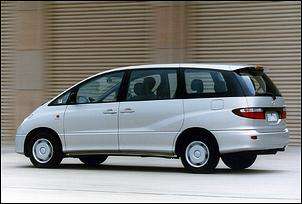
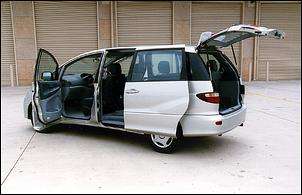
Who says people movers can't have any appeal? The third-generation Toyota Tarago delivers excellent comfort, abundant space and practicality and - despite its image - drives much like a (good) conventional car.
Lots of vehicles on the Australian market come with the 'people mover' tag - everything from Ford Falcon wagons with an extra row of seats, to the small car-based Kia Carens. But when it comes to sheer spaciousness and flexibility, the current Tarago competes only with Chrysler's Voyager ($49,900-67,400), the Kia Carnival ($32,990-39,000), Mitsubishi Starwagon GLX ($48,600) and Mazda MPV ($49,990).
Toyota offers the Tarago in three equipment levels - the tested $51,300 GLi, the GLX at $57,550 and the $64,100 Ultima... no, these are not cheap vehicles.
The tested GLi offers seating for eight and appointments such as remote central locking, 6-speaker radio/cassette, rear air conditioning vents and power front windows. Anti-lock brakes and electronic brake force distribution (EBD) are extra cost options.
Despite being more expensive than its opposition (well, all but the top-line Chrysler Voyager anyway), the Tarago range is clearly dominating the Australian large people mover niche - and after driving the vehicle, that's no surprise...
Driveline
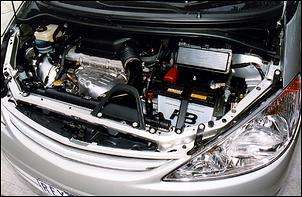
The double overhead cam engine is a competent, modern design. With a capacity of 2.4 litres and featuring VVT-i (Variable Valve Timing with Intelligence), the 16-valve 2AZ-FE all-alloy four develops 115kW at 5600 rpm and 221Nm at 4000 rpm. However, with the exception of the completely gutless (85kW) Mitsubishi Starwagon, the Tarago is out-gunned in the power and torque departments by all its opposition.
That it can still scrape by is thanks to the strong spread of torque afforded by VVT-i - a system which infinitely adjusts intake valve timing over a 50-degree range. Variable valve timing gives good driveability and allows the Tarago to keep up with traffic flow without stress - but fill the cabin with people and attempt to climb a hill, and the lack of power is evident.
Another advantage of VVT-I is that it enhances fuel consumption. We averaged around between 11-12.5 litres per 100km during our test, which included a mix of heavy traffic, suburban roads and open highways. In contrast, the official AS2877 figures suggest 10.0 and 6.6 litres per 100km in the city and on the highway respectively. The engine's relatively low 9.6:1 compression ratio and knock sensing system allows the use of cheap 91-octane normal unleaded fuel.
The third generation Tarago is offered only as an automatic. The new 4-speed U241E transaxle shifts quickly, smoothly and is quite intelligent - but it does hold overdrive (or the torque converter lock-up, or both) a smidgin too long as the vehicle begins climbing slight inclines. Under these conditions, the engine becomes unresponsive to small throttle movements and there's increased noise and vibration - the engine simply doesn't have enough torque to cope smoothly. When the trans does finally decide to drop back a gear, all is again fine.
On the Road
The Tarago's body is quite large and requires some careful placement on narrow roads - but it's a job that's made easy by responsive steering. Using a power-assisted rack and pinion arrangement (with Toyota's so-called Nachlauf front-end geometry), the system has linear feel, good weight and feedback - though the ratio is slightly slow around centre.
Despite the lack of ABS, in an emergency stop the GLi comes to a halt rapidly and with good stability. However, in this class of car the driver shouldn't have to be cadence braking to avoid lock-ups....
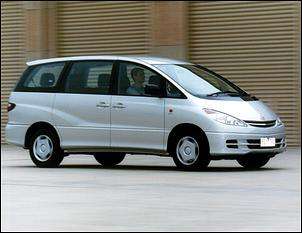
Built on a 2900mm wheelbase, the Tarago has excellent directional stability and ride comfort. Unlike previous Taragos (which used a mid-engine'd rear drive layout), this model uses a transverse front-engine, front-drive configuration. This design approach has created typical FWD-style handling - the Tarago will go into mild, predictable understeer when pushed. But it's a very safe set-up, with no throttle lift-off oversteer. Adequate grip is provided by 205/65 tyres mounted on 15-inch steel wheels.
Long-travel MacPherson front struts and a trailing torsion beam axle with coil springs give a comfortable ride - though it is slightly too firm when the cabin isn't carrying many kilos. Adding weight softens the ride out noticeably.
Noise Vibration and Harshness (NVH) levels are kept commendably low. Dual contra-rotating engine balance shafts, anti-vibration suspension sub-frames and supports, a two-stage rear muffler and extensive use of sound deadening material all make a difference. At high speed, wind noise is minimal - there's just a bit of rustling around the base of the A-pillar.
Interior Flexibility
People movers are bought for their carrying capacity and versatility - so what's the Tarago like?
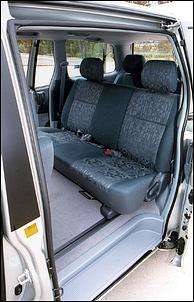
Starting at the rearmost row, the 8-seater offers a reclining bench seat, which can be slid a massive 825mm fore-aft or pivoted up at the base. With the seat is slid fully forward there's adequate legroom - but if you slide it all the way back and there's simply a huge abundance of space. The volume of the rear cargo area in each extreme varies accordingly - from barely-enough-to-fit-the-weekly-shopping all the way through to chuck-in-a-bunch-of-large-suitcases. Cargo access is made easy by a low load lip - although the tailgate should lift higher as it's possible for tall people to hit their heads on it - and there's a 12-volt power socket in the back for convenience.
The forward bench seat - the centre row - slides fore-aft 485mm and has a reclining backrest that can be laid horizontally, matching up to the seat cushion behind. You could use this huge, flat cushioned area as a double bed if the need ever came up. Ensuring rear occupant comfort are air conditioning vents and controls which are installed above the heads of both the second and third row passengers. Sliding doors are positioned on both sides of the Tarago.
The front doors open wide and with a relatively low floor for a one-box car shape, access to the front seats is easy. These individual seats can be slid back and forth by 240mm, feature a fold-down centre arm rest, and - like all seats in the Tarago - are very comfortable. Generous headroom and a flat floor allow walk-through central access to the rear.
Remaining up front, there is plenty of stowage for personal items - a total of 21 storage areas can be found throughout the vehicle - and the massive front door pockets prove very handy. They're big enough to swallow a large format street directory, drink bottle, handbag, mobile phone and all you could possibly fit into your pockets.
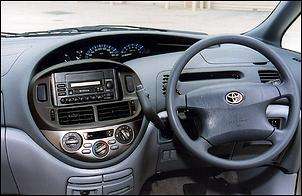
The sculpted dashboard is a focal piece. Curving forward into the middle of the cabin, it forms a centre control centre for ventilation, air conditioning, hazard lights, LED clock and radio/cassette. The radio cassette head unit - which plays through six speakers including front tweeters - is the same one you'll find in a current Corolla. It's OK without being brilliant. Other cabin features include a lights-on warning beeper, auto lights setting and power exterior mirrors. Power windows are fitted only in the front - second row passengers use manual window winders, while the rearmost side glass is fixed.
The centrally mounted instrument cluster for road speed, engine revs, fuel level and coolant temperature is an unfortunate case of style over function. As in the little Toyota Echo, the centre placement requires that the driver takes a deliberate look across to the instruments to see any readings. In most cars, the dials in front of the driver are very nearly in peripheral vision.... but not in the Tarago. Unlike the Echo, however, the Tarago uses easy-to-read analogue gauges - this makes their identification a little quicker. Perhaps in an admission that the location of the Tarago's instruments is les than ideal, the emergency warning lights are positioned in a neat line directly in front of the driver!
To help maintain its good walk-through access, the Tarago keeps its park brake and gear selector off the floor. A foot-operated park brake - as fitted to the Toyota Avalon - is light and easy to operate, but the gear selector is not as successful. For this function an oddly angled 'pistol grip' lever sprouts from the dashboard - it's easy for the driver to bump it with their left knee.
Looks Good
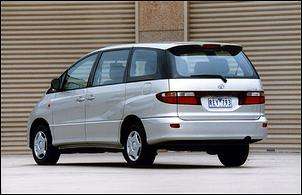
One of the most striking aspects of the current Tarago is its styling. The Peugeot 206-ish multi-reflector headlights - in addition to performing very well at night - give the front-end a very sharp look, while the massive rake of the windscreen creates an appealing wedge profile. The side flanks are kept clean with the sliding door rails hidden at the base of the window line, while so-called 'character lines' break up the slab-sides. Sharply styled lights are again used on the tail, with wrap-around style windows and a subtle roof spoiler - incorporating a high-mount brake light - used to help reduce rear aerodynamic lift and drag. This spoiler and a gradually tapering roofline contribute to the Tarago's superb claimed 0.30 Cd figure - 0.02 down on the previous model.
In addition to its beauty and aero efficiency, the new Tarago body boasts increased rigidity and less weight - despite its substantial body structure, at 1640kg it weighs around 85kg less than its predecessor.
Safety is, of course, a major issue when you're talking people movers. Specific safety features include dual front airbags, a four-way collapsible steering column, auto-retracting brake pedal and adjustable front seatbelt anchorages with pre-tensioners and force-limiters. There's also an accident fuel shut-off, sliding door inter-locks, energy absorbing materials built into the B, C and D-pillars and roof side trim, a full set of adjustable headrests and second row auto locking retractor (ALR) seatbelts. Three child restraint anchorages are fitted on the back of the second row seat, allowing unrestricted access to the third row seats. Four tie-down hooks secure rear cargo.
All-round visibility is quite good, with a divided A-pillar (creating a small front quarter window), massive front windscreen, wide-sweeping wipers (on eccentric arms) and large mirrors. And don't underestimate the accident avoidance benefits of the high, see-all driving position.
Conclusion
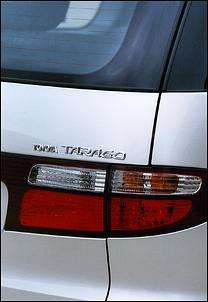
The Tarago scores very well - it's a full-sized 8-seater with very few driving trade-offs over a conventional sedan/wagon. Like all current model Toyotas, it's also exceptionally well built. Trim fabrics are high quality, panel margins are tight, paint quality is excellent and - overall - you get the feeling this is a vehicle that'll last forever.
The biggest drawback is its relatively high price. Knock off a couple of thousand dollars (or perhaps throw in ABS and EBD as standard) and it'd be a much more attractive proposition. However, partly offsetting this is Toyota's reputation for excellent retained values - we predict the Tarago will depreciate more slowly than its competitors. (But note the short-term depreciating effect of ex-Government and ex-rental vehicles being sold cheaply at auctions...)
The Tarago is an impressive and effective vehicle. It has far more interior room than conventional cars, while the driving downsides are relatively few.
We were certainly impressed... but if buying the big Toyota, make sure that the ABS option box is ticked.
|
Более 2000 руководств по ремонту и техническому обслуживанию автомобилей различных марок |
||
 |
 |
|
